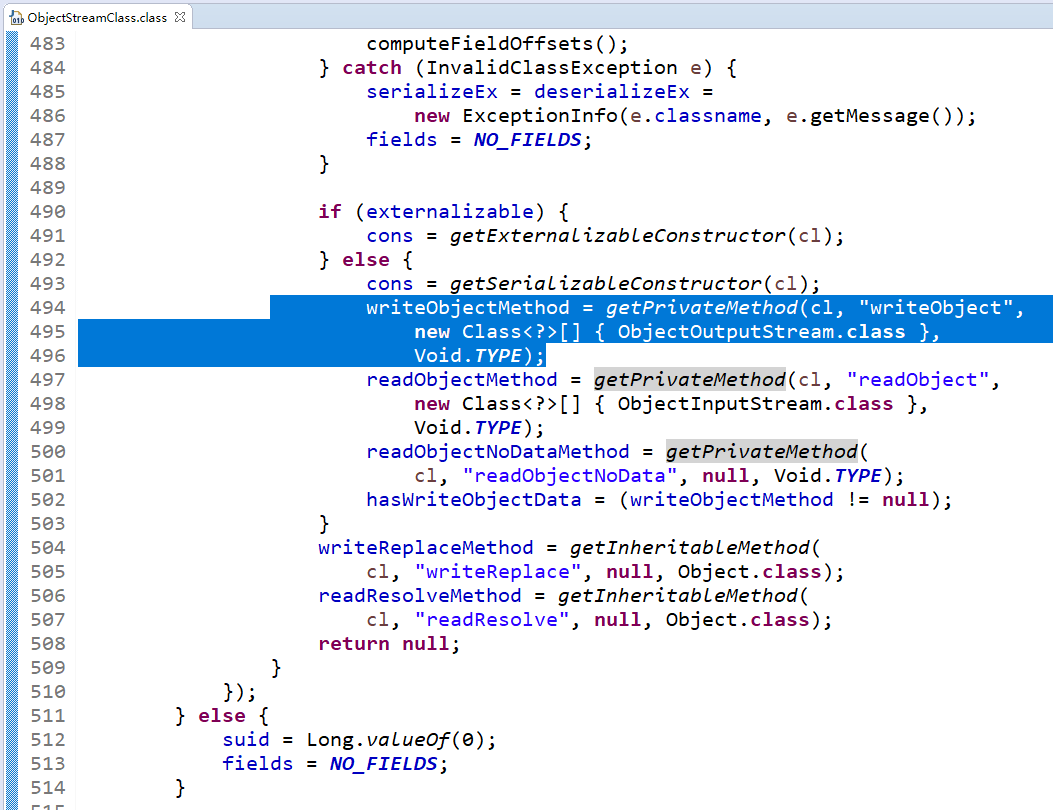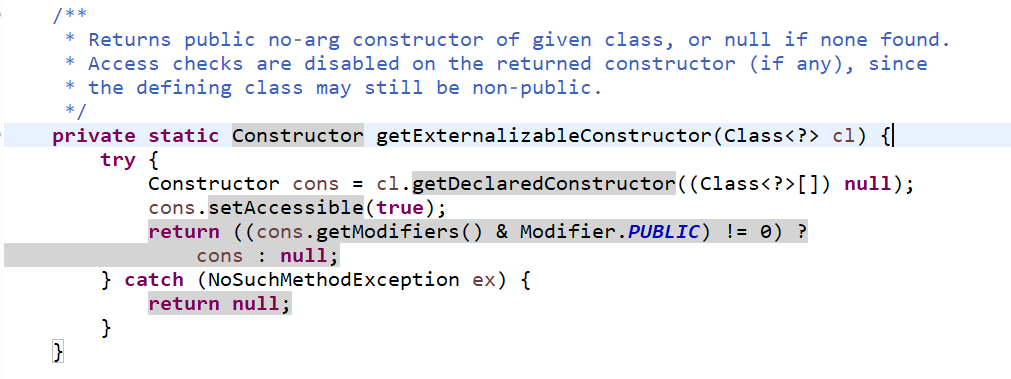Java序列化是指把Java对象转换为字节序列的过程;而Java反序列化是指把字节序列恢复为Java对象的过程。从而达到网络传输、本地存储的效果。
本文主要要看看JDK中使用Serializable和Externalizable接口来完成Java对象序列化,并给出部分属性序列化的几种方式,最终做出Serializable和Externalizable接口的几个方面的对比。
注:本文不讨论为什么不用第三方工具包完成序列化等~
序列化Serializable
要实现Java对象的序列化,只要将类实现Serializable或Externalizable接口即可。
采用类实现Serializable接口的序列化很简单,Java自动会将非transient修饰属性序列化到指定文件中去。
举个例子:
import java.io.Serializable;
import java.util.List;
/**
* @Type Book.java
* @Desc
* @author wangmengjun
* @date 2017年12月1日 下午7:16:29
* @version
*/
public class Book implements Serializable {
private static final long serialVersionUID = -6212470156629515269L;
/**书名*/
private String name;
/**ISBN*/
private String isbn;
/**作者*/
private List<String> authors;
/**
* @return the name
*/
public String getName() {
return name;
}
/**
* @param name the name to set
*/
public void setName(String name) {
this.name = name;
}
/**
* @return the isbn
*/
public String getIsbn() {
return isbn;
}
/**
* @param isbn the isbn to set
*/
public void setIsbn(String isbn) {
this.isbn = isbn;
}
/**
* @return the authors
*/
public List<String> getAuthors() {
return authors;
}
/**
* @param authors the authors to set
*/
public void setAuthors(List<String> authors) {
this.authors = authors;
}
/* (non-Javadoc)
* @see java.lang.Object#toString()
*/
@Override
public String toString() {
return "Book [name=" + name + ", isbn=" + isbn + ", authors=" + authors + "]";
}
}
然后编写一个用于序列化和反序列的小工具类,
import java.io.BufferedInputStream;
import java.io.BufferedOutputStream;
import java.io.FileInputStream;
import java.io.FileOutputStream;
import java.io.IOException;
import java.io.ObjectInputStream;
import java.io.ObjectOutputStream;
/**
* @Type SerializationUtil.java
* @Desc
* @author wangmengjun
* @date 2017年12月1日 下午7:23:04
* @version
*/
public class SerializationUtil {
/**
* 从一个给定的文件完成反序列化
*/
public static Object deserialize(String fileName) throws IOException,
ClassNotFoundException {
FileInputStream fis = new FileInputStream(fileName);
BufferedInputStream bis = new BufferedInputStream(fis);
ObjectInputStream ois = new ObjectInputStream(bis);
Object obj = ois.readObject();
ois.close();
return obj;
}
/**
* 将给定的对象序列化到指定的文件中去
*/
public static void serialize(Object obj, String fileName)
throws IOException {
FileOutputStream fos = new FileOutputStream(fileName);
BufferedOutputStream bos = new BufferedOutputStream(fos);
ObjectOutputStream oos = new ObjectOutputStream(bos);
oos.writeObject(obj);
oos.close();
}
}
写个测试类,测试一下:
public class SerializableTest {
public static void main(String[] args) throws IOException, ClassNotFoundException {
Book book = new Book();
book.setIsbn("ABC123456789");
book.setName("Hello Java");
book.setAuthors(Arrays.asList("John","Eric"));
//book==>Book [name=Hello Java, isbn=ABC123456789, authors=[John, Eric]]
System.out.println("book==>" + book);
/**
* 将book对象序列化到book.temp文件中去
*/
String fileName = "book.temp";
SerializationUtil.serialize(book, fileName);
/**
* 从book.temp文件中,反序列化一个Book对象
*/
Book deserializedBook = (Book) SerializationUtil.deserialize(fileName);
//deserializedBook==>Book [name=Hello Java, isbn=ABC123456789, authors=[John, Eric]]
System.out.println("deserializedBook==>" + deserializedBook);
}
}
一个简单的示例,就完成了Book对象的序列化和反序列化。
在上述示例中,Book对象中的所有的属性都被序列化。如果里面存在部分属性,我们不想要被序列化,该如何做呢?
部分属性序列化
如果只想将部分属性进行序列化,可以采用如下几种方法:
- 使用transient关键字
- 添加writeObject和readObject方法
- 使用Externalizable实现
使用transient关键字
对属性添加transient关键字,可以防止该属性序列化~
如下示例中,我们不想isbn和authors属性被序列,添加上transient关键字实现一下~
public class Book implements Serializable {
private static final long serialVersionUID = -6212470156629515269L;
/** 书名 */
private String name;
/** ISBN */
private transient String isbn;
/** 作者 */
private transient List<String> authors;
... ...
}
运行上述提到的SerializableTest.java程序,输出如下结果,我们可以看出isbn和authors的值都为null,表明这两个属性没有被序列化~
book==>Book [name=Hello Java, isbn=ABC123456789, authors=[John, Eric]]
deserializedBook==>Book [name=Hello Java, isbn=null, authors=null]添加writeObject和readObject方法
另外,我们也可以采用编写私有方法writeObject和readObject,完成部分属性的序列化。修改Book类,增加writeObject 和 readObject方法,如:
public class Book implements Serializable {
private static final long serialVersionUID = -6212470156629515269L;
/** 书名 */
private String name;
/** ISBN */
private String isbn;
/** 作者 */
private List<String> authors;
private void writeObject(ObjectOutputStream oos) throws IOException {
// oos.defaultWriteObject();
oos.writeObject(name);
oos.writeObject(isbn);
}
private void readObject(ObjectInputStream ois) throws IOException, ClassNotFoundException {
// ois.defaultReadObject();
name = (String) ois.readObject();
isbn = (String) ois.readObject();
}
... ...
}
在上述示例中,我们选择序列化的属性为name和isbn,书本作者authors没有序列化~
同样,使用SerializableTest.java类测试一下,结果如下:
book==>Book [name=Hello Java, isbn=ABC123456789, authors=[John, Eric]]
deserializedBook==>Book [name=Hello Java, isbn=ABC123456789, authors=null]注意:
这里的writeObject和readObject是private的且是void的~
Java调用ObjectOutputStream类检查其是否有私有的,无返回值的writeObject方法,如果有,其会委托该方法进行对象序列化。
检查是否有合适的方法如下:

使用Externalizable实现
还有一种方式,就是使用Externalizable完成部分属性的序列化。
Externalizable继承自Serializable,使用Externalizable接口需要实现writeExternal以及readExternal方法~在writeExternal方法中,写入想要外部序列化的元素~
public interface Externalizable extends java.io.Serializable {
/**
* The object implements the writeExternal method to save its contents
* by calling the methods of DataOutput for its primitive values or
* calling the writeObject method of ObjectOutput for objects, strings,
* and arrays.
*
* @serialData Overriding methods should use this tag to describe
* the data layout of this Externalizable object.
* List the sequence of element types and, if possible,
* relate the element to a public/protected field and/or
* method of this Externalizable class.
*
* @param out the stream to write the object to
* @exception IOException Includes any I/O exceptions that may occur
*/
void writeExternal(ObjectOutput out) throws IOException;
/**
* The object implements the readExternal method to restore its
* contents by calling the methods of DataInput for primitive
* types and readObject for objects, strings and arrays. The
* readExternal method must read the values in the same sequence
* and with the same types as were written by writeExternal.
*
* @param in the stream to read data from in order to restore the object
* @exception IOException if I/O errors occur
* @exception ClassNotFoundException If the class for an object being
* restored cannot be found.
*/
void readExternal(ObjectInput in) throws IOException, ClassNotFoundException;
}
修改Book类的内容,如下:
import java.io.Externalizable;
import java.io.IOException;
import java.io.ObjectInput;
import java.io.ObjectOutput;
import java.util.List;
/**
* @Type Book.java
* @Desc
* @author wangmengjun
* @date 2017年12月1日 下午7:16:29
* @version
*/
public class Book implements Externalizable {
/** 书名 */
private String name;
/** ISBN */
private String isbn;
/** 作者 */
private List<String> authors;
@Override
public void writeExternal(ObjectOutput out) throws IOException {
out.writeObject(name);
out.writeObject(isbn);
}
@Override
public void readExternal(ObjectInput in) throws IOException, ClassNotFoundException {
name = (String) in.readObject();
isbn = (String) in.readObject();
}
/**
* @return the name
*/
public String getName() {
return name;
}
/**
* @param name
* the name to set
*/
public void setName(String name) {
this.name = name;
}
/**
* @return the isbn
*/
public String getIsbn() {
return isbn;
}
/**
* @param isbn
* the isbn to set
*/
public void setIsbn(String isbn) {
this.isbn = isbn;
}
/**
* @return the authors
*/
public List<String> getAuthors() {
return authors;
}
/**
* @param authors
* the authors to set
*/
public void setAuthors(List<String> authors) {
this.authors = authors;
}
/*
* (non-Javadoc)
*
* @see java.lang.Object#toString()
*/
@Override
public String toString() {
return "Book [name=" + name + ", isbn=" + isbn + ", authors=" + authors + "]";
}
}
同样,使用SerializableTest.java类测试一下,同样获得如下结果:
book==>Book [name=Hello Java, isbn=ABC123456789, authors=[John, Eric]]
deserializedBook==>Book [name=Hello Java, isbn=ABC123456789, authors=null]
Externalizable vs Serializable
Externalizable和Serializable的一些比较点,如下:
【1】 Serializable 是标识接口
public interface Serializable {
}
实现该接口,无需重写任何方法;
public interface Externalizable extends java.io.Serializable {
void writeExternal(ObjectOutput out) throws IOException;
void readExternal(ObjectInput in) throws IOException, ClassNotFoundException;
}
Externalizable 接口继承于Serializable,实现该接口,需要重写readExternal和writeExternal方法~
【2】Serializable提供了两种方式进行对象的序列化,
- 采用默认序列化方式,将非transatient和非static的属性进行序列化
- 编写readObject和writeObject完成部分属性的序列化
Externalizable 接口的序列化,需要重写writeExternal和readExternal方法,并且在方法中编写相关的逻辑完成序列化和反序列化。
【3】Externalizable接口的实现方式一定要有默认的无参构造函数~

如果,没有无参构造函数,反序列化会报错~ 验证一下~ Book添加一个有参数的Book构造函数~
public class Book implements Externalizable {
/** 书名 */
private String name;
/** ISBN */
private String isbn;
/** 作者 */
private List<String> authors;
public Book(String name) {
this.name = name;
}
... ...
}
这样,序列化、反序列化之后,报no valid constructor的异常~
Exception in thread "main" java.io.InvalidClassException: Book; no valid constructor at java.io.ObjectStreamClass$ExceptionInfo.newInvalidClassException(ObjectStreamClass.java:150) at java.io.ObjectStreamClass.checkDeserialize(ObjectStreamClass.java:768) at java.io.ObjectInputStream.readOrdinaryObject(ObjectInputStream.java:1772) at java.io.ObjectInputStream.readObject0(ObjectInputStream.java:1350) at java.io.ObjectInputStream.readObject(ObjectInputStream.java:370) at SerializationUtil.deserialize(SerializationUtil.java:27) at SerializableTest.main(SerializableTest.java:33)
Serializable接口实现,其采用反射机制完成内容恢复,没有一定要有无参构造函数的限制~
【4】采用Externalizable无需产生序列化ID(serialVersionUID)~而Serializable接口则需要~
【5】相比较Serializable, Externalizable序列化、反序列更加快速,占用相比较小的内存
在项目中,大部分的类还是推荐使用Serializable, 有些类可以使用Externalizable接口,如:
- 完全控制序列的流程和逻辑
- 需要大量的序列化和反序列化操作,而你比较关注资源和性能~ 当然,这种情况下,我们一般还会考虑第三方序列化/反序列化工具,如protobuf等进行序列化和反序列化操作~
转载:Serializable和Externalizable浅析 - 王孟君的个人空间 - OSCHINA - 中文开源技术交流社区
拓展资料1:Java transient关键字使用小记